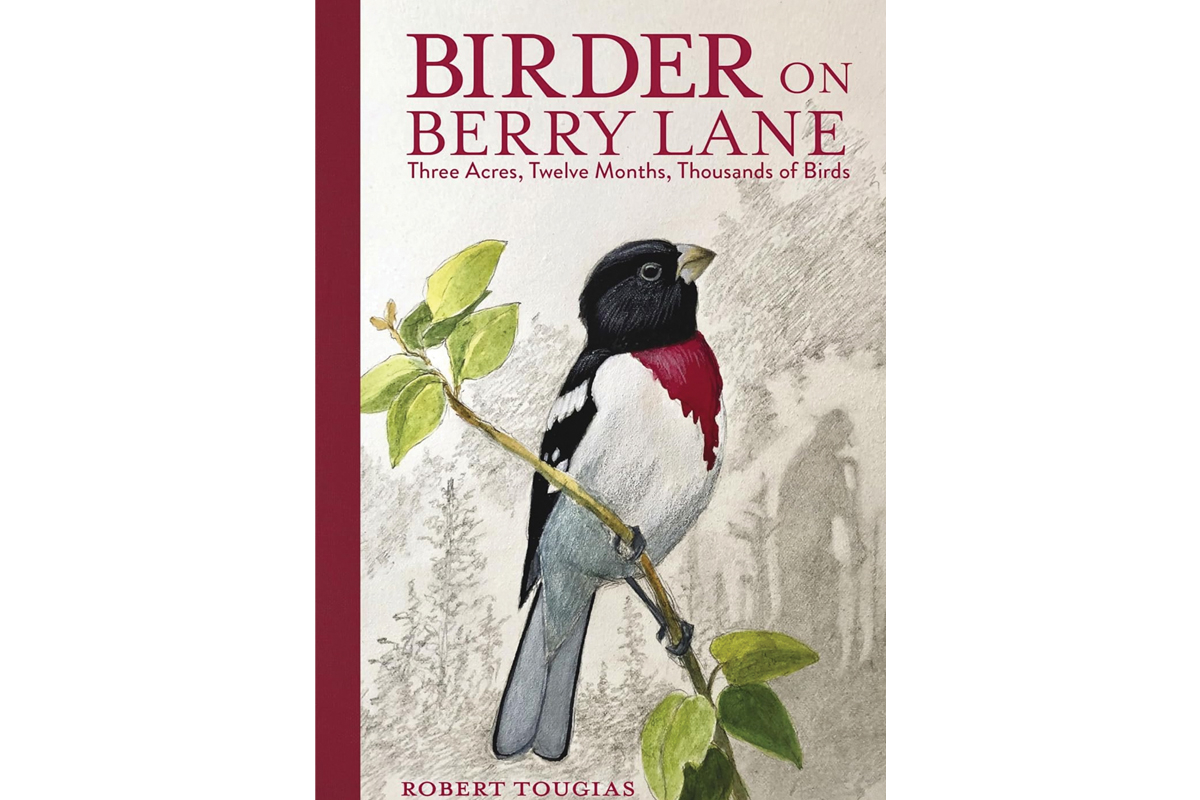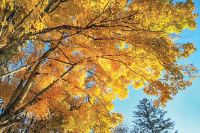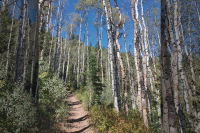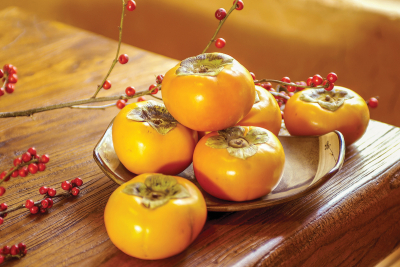Staring up at the branches on ‘Berry Lane’

A month ago, on a day that was officially in winter but which felt like spring, I was walking in the woods near my house.
I’d like to say that my mind was in the woods, but it wasn’t. It was running on some other path, on some matter which I’ve forgotten, because it wasn’t important. But nature intervened. Out of the blue I heard a toad sing, the first of the year for me.
The singing of a toad is my favorite thing about spring, the most beautiful thing I can imagine, a sound that makes me unexplainably happy, and on this walk I was completely surprised. In years past I remember being on the porch, at home, in the evening. Hearing it in the woods during the day, while I was distracted, added a new level of the unexpected.
Robert Tougias would understand. He writes this about hearing a wood thrush sing: “Listening to a thrush sing is a spiritual experience for me; it seems the most natural and truest form of inspiration. The song of the thrush speaks to me of the beauty and magnificence in nature. It moves my emotions …. To hear the thrush at close range, as I have on a few occasions, is a peak experience.”
Tougias is a Connecticut naturalist who writes a newspaper column and gives talks about, primarily, birds. From the response to his writing and talks, he gathered that people enjoyed most the stories of the birds he heard and saw in his neighborhood, and he wrote a book on that subject, “Birder on Berry Lane” (Charlesbridge Publishing, 2020, 190 pp). He includes a map. Front yard and back yard and vegetable garden, the trees surrounding the yard, his wood lot, a bordering creek and a meadow beyond the creek. Habitat, in other words. And plenty of feeders. “Must remember to stop by the feed store,” he reminds himself.
The stories come when Tougias listens and moves in that world, aware and curious about what the birds are doing. He is awakened one morning in June by “the sweet warble of a bluebird.” But why is the bluebird warbling in June, singing a spring song? And why is the song getting faster and louder? Tougias gets up to investigate. The singer is a male bluebird who has spotted a rival. Then the rival attacks. “A chase ensues, and the two birds fly around the yard at a dizzying speed …. Around and around they go, circling the spruce … slashing through the blueberry bushes … ripping across the foliage of oaks, hickories, and hemlocks.” One of the bluebirds cuts through the spruce in a shortcut maneuver and slams the other in the side. They continue the fight on the ground. “I can see the assault of wings, pecking, bill-snapping…” Finally, one flies away, defeated.
Related Items
We go with the author on cold nighttime walks to hear and call owls. There are searches for nests, and hikes just to see what shows up. All the things that naturalists do. Thank goodness for the naturalists. I will never see all that they see, but they help me trust it is there and, somehow, I breathe easier with that trust.
Like every naturalist I’ve known about, Tougias’ interest began when he was young. He describes his first venture into “the brambles,” where “giant bumblebees and twenty-foot snakes” were rumored to live. “I can vividly remember nervously watching every step.” He was 10. He didn’t see either of those scary giant creatures, but he heard a strange bird calling from a dense thicket and slowly crawled in to investigate. “As I parted the shrubbery to clear my advance, I looked up and saw a fierce yellow eye peering down at me from a nest made of fine twigs.” He knew immediately, remembering the pictures in the guide books he studied, that he was seeing a Brown Thrasher for the first time.
And like every nature lover, Togias feels sadness when habitat is lost. One of his favorite birding sites, a dense shrubby area full of birds, including the now increasingly uncommon Brown Thrasher, was being cleared for the construction of a new town maintenance facility as he wrote his book. The site bordered a highway. “My guess,” he says, “is that hundreds if not thousands of cars will pass along this highway each day, yet not a single traveler will know of the funny, flashy, foxy-brown bird with the intense yellow eyes, long tail, and dangerously curved beak that once called this roadside home.”
One thing I love about Tougias is the way he includes a few people in his stories, giving us just glimpses. He lives with his teenage daughter Heather. When a hurricane causes the power to go out, “I fumble around with a flashlight, and Heather and I live on crackers and no heat for two whole days. We play a game of Life and pet our cat Stripe by the light of a candle.”
He runs into his neighbor Lily while checking the mailbox. They catch up, then Lily asks, “Why were you staring up at the branches over your driveway a few days ago?” Blue jays, he answers, then points out the leafless branch the jays sit on to assess danger before going to the feeder. The talk moves to owls. He admits that he hoots to call them. Maybe she thinks he’s crazy, he says. No. The neighbors have all become more interested in birds because of his “passion,” she tells him.
The same goes for me. I check in with this book from time to time, and I hear and see more birds. I talk about them, too, and the interest spreads. The other day I was walking in my driveway with a three-year-old friend of mine. “The birds are singing for us,” she told me. Yes they are.
(Anne Bevilacqua is a book lover who lives in Haywood County. This email address is being protected from spambots. You need JavaScript enabled to view it..)

















